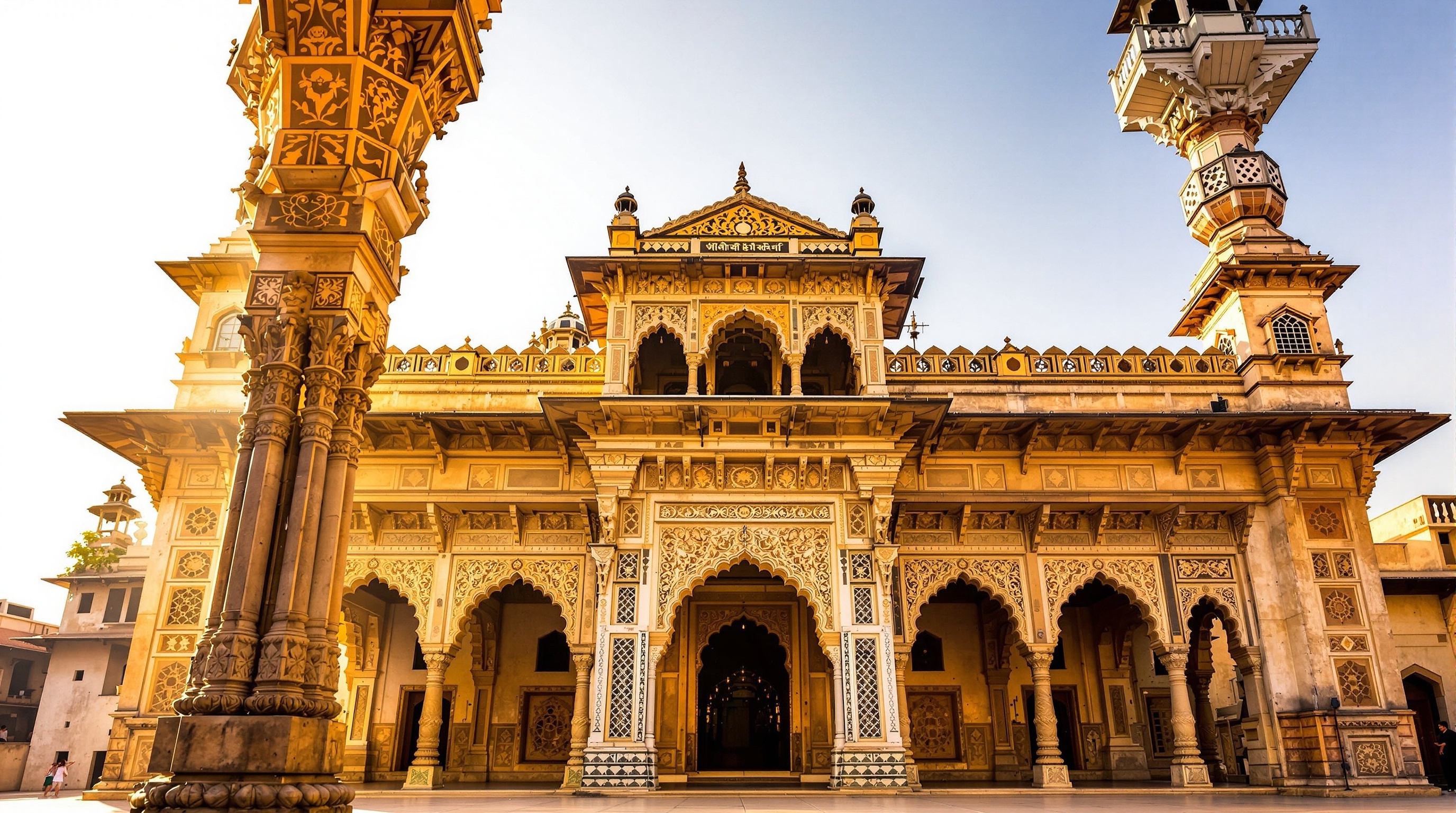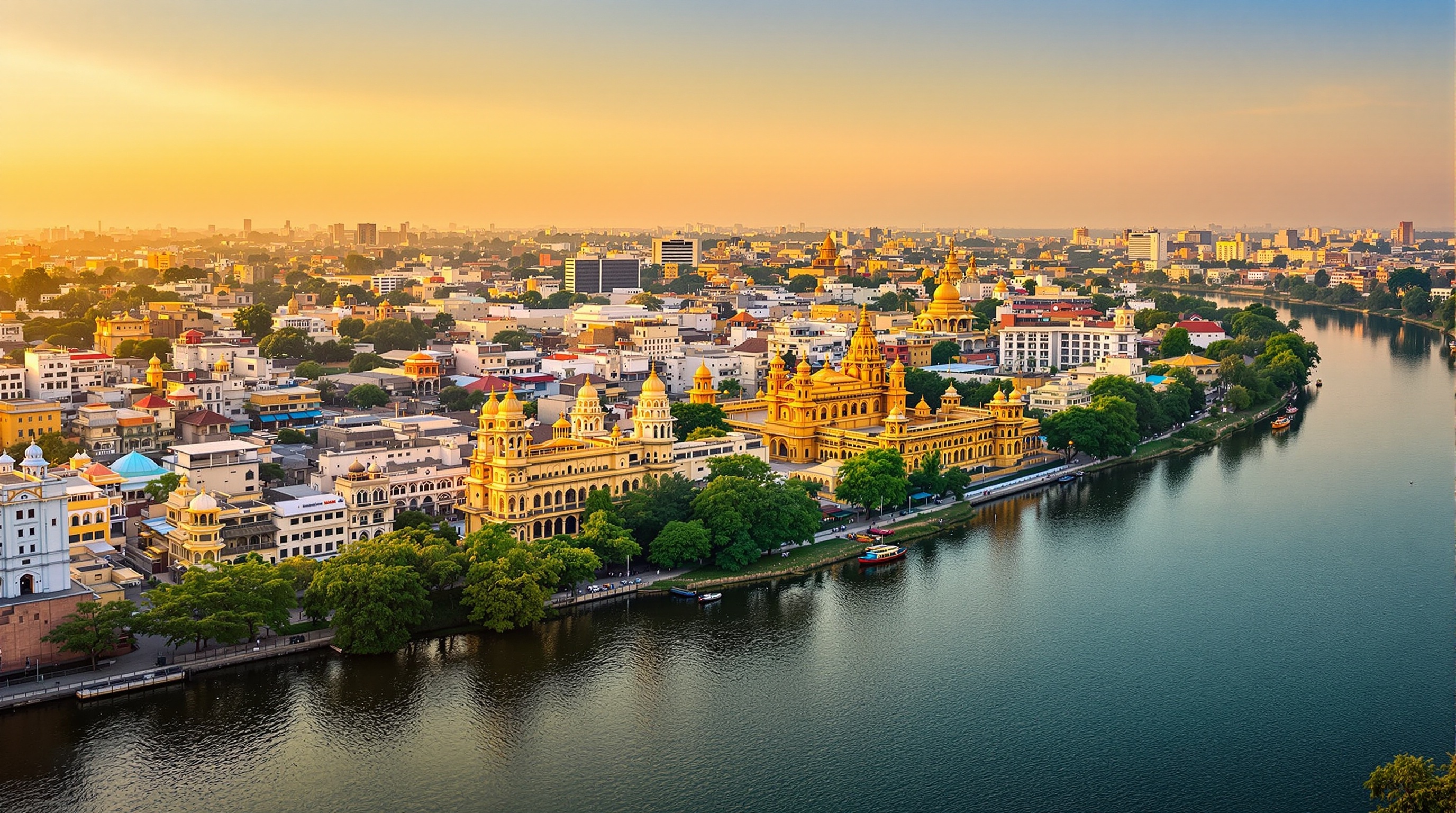Welcome to Bharuch - Gujarat's Historic Treasure
Where Ancient Heritage Meets Modern Gujarat
Nestled gracefully on the banks of the sacred Narmada River, Bharuch stands as one of Gujarat's most captivating destinations, offering travelers an extraordinary journey through time. Known historically as Bharukaccha or Broach, this ancient city has been a witness to over 2,000 years of Indian civilization, serving as a crucial maritime trading post that connected India with the Arabian Peninsula, Africa, and beyond.
Today's Bharuch is a fascinating tapestry where ancient temples echo with centuries-old prayers, traditional havelis showcase exquisite Gujarati architecture, and the mighty Narmada continues its eternal flow toward the Arabian Sea. The city's strategic location, approximately 70 kilometers south of Vadodara and 150 kilometers north of Surat, makes it an ideal base for exploring Gujarat's diverse attractions while experiencing authentic Gujarati culture.
What makes Bharuch truly special is its ability to preserve its historical essence while embracing modernity. The city's bustling markets still sell traditional handicrafts and textiles, local restaurants serve authentic Gujarati thalis that have remained unchanged for generations, and festivals like Navratri transform the entire city into a celebration of color, music, and dance.
A Gateway to Gujarat's Soul
Bharuch serves as more than just a tourist destination; it's a gateway to understanding Gujarat's soul. The city's significance extends beyond its historical importance - it's a living museum where every street corner tells a story, every temple holds centuries of devotion, and every local resident embodies the warmth and hospitality that Gujarat is famous for worldwide.
The Narmada River, considered one of India's most sacred waterways, adds a spiritual dimension to Bharuch's appeal. Pilgrims from across India visit the city to perform religious rituals along the ghats, while nature enthusiasts are drawn to the river's serene beauty and the rich biodiversity of its surrounding areas. The famous Golden Bridge (Sardar Bridge) spanning the Narmada has become an iconic symbol of the city, representing the perfect harmony between engineering excellence and natural beauty.

Traditional Gujarati architecture showcasing intricate craftsmanship
Why Bharuch Should Be Your Next Destination
Discover What Makes This City Extraordinary
Rich Heritage & Culture
Experience 2000+ years of history through magnificent temples, ancient architecture, and time-honored traditions that continue to thrive in modern times.
Sacred Narmada River
Witness the spiritual significance of one of India's holiest rivers, with beautiful ghats, serene boat rides, and breathtaking sunset views.
Authentic Gujarati Cuisine
Savor traditional flavors in local eateries and experience the famous Gujarati thali culture that celebrates vegetarian culinary excellence.
Traditional Handicrafts
Discover exquisite textiles, jewelry, and handicrafts in vibrant local markets that showcase Gujarat's renowned craftsmanship traditions.
Vibrant Festivals
Participate in colorful celebrations like Navratri, where traditional garba and dandiya create an atmosphere of joy and cultural immersion.
Strategic Location
Perfect base for exploring Gujarat, with easy access to major cities, wildlife sanctuaries, and other cultural destinations throughout the state.
A Journey Through Time - Bharuch's Remarkable History
From Ancient Trading Hub to Modern Gujarat Gem
Ancient Maritime Capital
Bharuch, known as Bharukaccha in ancient times, emerged as one of India's most important seaports. Greek and Roman texts mention it as a thriving center for international trade, connecting Indian merchants with Arabian, African, and Mediterranean markets. The city's strategic location at the mouth of the Narmada made it the perfect gateway for goods flowing between inland India and overseas markets.
Golden Age of Trade
During the medieval period, Bharuch reached unprecedented prosperity as Arab and Persian merchants established permanent trading posts. The city became famous for its textile exports, particularly cotton fabrics and silk, which were highly prized in international markets. This period saw the construction of many architectural marvels that still stand today, showcasing the wealth and cultural sophistication of medieval Bharuch.
Mughal Era Influence
Under Mughal rule, Bharuch continued to flourish as a major commercial center. The Mughals recognized the city's economic importance and invested heavily in infrastructure development. Many of the city's Islamic architectural elements date from this period, creating a unique fusion of Hindu, Islamic, and Gujarati architectural styles that characterizes Bharuch's built heritage today.
European Colonial Period
The arrival of European traders brought new dynamics to Bharuch's economy. British, Dutch, and Portuguese merchants competed for trade privileges, leading to the establishment of European quarters within the city. This period introduced new architectural styles and urban planning concepts while traditional Gujarati culture adapted and evolved in response to global influences.
Modern Bharuch
Post-independence Bharuch has transformed into a major industrial and petrochemical hub while carefully preserving its cultural heritage. The city now hosts several multinational corporations and has become a significant contributor to Gujarat's economic growth. Despite rapid industrialization, Bharuch has maintained its traditional character, making it an ideal destination for travelers seeking both cultural authenticity and modern amenities.
Experience Bharuch's Living Culture
Immerse Yourself in Authentic Gujarati Traditions
Spiritual Heritage
Bharuch's spiritual landscape is dominated by ancient temples that have been centers of devotion for centuries. The Swaminarayan Temple, with its intricate carvings and peaceful atmosphere, offers visitors a glimpse into Gujarat's rich religious traditions. The city's numerous Jain temples reflect the community's historical importance in trade and commerce, while Hindu temples dedicated to various deities showcase the diversity of Indian spiritual practices.
The morning and evening aartis (prayer ceremonies) at various temples create a mystical atmosphere that transports visitors to a different era. Participating in these rituals provides deep insights into the spiritual practices that have shaped Gujarati culture for millennia. The temple architecture itself tells stories of devotion, artistic excellence, and the seamless integration of spirituality into daily life.
Artistic Traditions
Bharuch has been a center for traditional Gujarati arts and crafts for centuries. The city's artisans continue to practice age-old techniques in textile weaving, block printing, and jewelry making. Visitors can witness master craftsmen at work in the old quarters of the city, where traditional workshops operate much as they did hundreds of years ago.
The local markets are treasure troves of authentic Gujarati handicrafts, including intricately embroidered textiles, traditional bandhani (tie-and-dye) fabrics, and exquisite silver jewelry. These crafts represent not just commercial products but living traditions that connect contemporary Bharuch with its rich artisanal heritage. Many families have been practicing these crafts for generations, passing down techniques and designs through oral tradition.
Musical Heritage
Music and dance are integral parts of Bharuch's cultural identity. The city comes alive during Navratri when traditional garba and dandiya performances fill every neighborhood. These aren't just tourist attractions but genuine community celebrations where visitors are welcomed to participate in the joyful revelry.
Throughout the year, classical music concerts and folk performances take place in temples and community centers. The city has produced several renowned musicians who have contributed to Gujarat's rich musical heritage. Traditional instruments like the tabla, harmonium, and dhol continue to be popular among young musicians, ensuring that musical traditions remain vibrant and relevant.
Architectural Legacy
Walking through Bharuch's old quarters is like journeying through a living architectural museum. Traditional Gujarati havelis with their characteristic wooden balconies, intricate stone carvings, and spacious courtyards demonstrate the sophisticated urban planning of earlier eras. Many of these heritage buildings have been carefully restored and continue to house families whose ancestors built them centuries ago.
The integration of different architectural influences - Hindu, Islamic, Parsi, and colonial European - creates Bharuch's unique architectural character. Each building tells a story of cultural adaptation and artistic innovation, making the city a fascinating study in how architectural styles evolve through historical interactions and cultural exchanges.
Natural Splendor of Bharuch
Where River Meets Sky in Perfect Harmony
The Narmada River is undoubtedly Bharuch's greatest natural asset, but the city's environmental treasures extend far beyond this sacred waterway. The river's journey through Bharuch creates a diverse ecosystem that supports rich biodiversity while providing stunning scenic vistas that change dramatically with the seasons and times of day.
Narmada River Ecosystem
The Narmada's flow through Bharuch creates a complex aquatic ecosystem that supports numerous bird species, including migratory birds that visit during winter months. The riverbanks are lined with native vegetation that provides habitat for various wildlife species. Early morning boat rides offer opportunities to observe kingfishers, egrets, and other water birds in their natural habitat.
The river's ghats (ceremonial steps leading to the water) are not just spiritual spaces but also important ecological interfaces where terrestrial and aquatic environments meet. These areas support unique plant communities adapted to the seasonal flooding cycles, creating micro-habitats that demonstrate nature's remarkable adaptability.
Urban Green Spaces
Despite its urban development, Bharuch has maintained several parks and gardens that provide green lungs for the city. These spaces serve as important gathering places for local communities while supporting urban biodiversity. Many parks feature native Gujarati flora, including traditional medicinal plants that have been used in Ayurvedic practices for centuries.
The city's tree-lined streets, particularly those planted during the colonial period, create natural cooling corridors that make walking through Bharuch pleasant even during warmer months. These mature trees support urban wildlife including various bird species and contribute significantly to the city's environmental quality.
Surrounding Landscapes
Bharuch's location in the Narmada valley provides access to diverse landscapes within short distances. The nearby Shoolpaneshwar Wildlife Sanctuary offers opportunities to experience Gujarat's natural heritage, including deciduous forests, tribal villages, and diverse wildlife populations. This proximity to protected natural areas makes Bharuch an excellent base for eco-tourism activities.
The gentle rolling hills surrounding the city create picturesque vistas, especially during monsoon season when the landscape transforms into a lush green carpet. These areas support traditional agriculture and provide insights into rural Gujarati life, making them popular destinations for cultural and agritourism experiences.
Planning Your Perfect Bharuch Experience
Essential Information for Memorable Travel
Best Time to Visit
Winter (November to February): Ideal weather conditions with pleasant temperatures ranging from 15°C to 28°C. Perfect for sightseeing, outdoor activities, and cultural exploration.
Post-Monsoon (September to October): Lush green landscapes and comfortable temperatures. Excellent for nature photography and river activities.
Festival Seasons: Plan around Navratri (September/October) for cultural immersion, or Diwali for spectacular light displays and traditional celebrations.
Getting to Bharuch
By Air: Nearest airport is Vadodara (70 km) with good connectivity to major Indian cities. Surat Airport (85 km) offers additional options.
By Train: Bharuch Railway Station is well-connected with regular services from Mumbai, Delhi, Ahmedabad, and other major cities.
By Road: Excellent highway connectivity via NH-8 and state highways. Regular bus services from Gujarat and neighboring states.
Accommodation Options
Heritage Hotels: Experience royal hospitality in converted palaces and havelis that offer authentic Gujarati architecture and cuisine.
Business Hotels: Modern amenities for comfortable stays with facilities for both leisure and business travelers.
Budget Accommodations: Clean, affordable options including guesthouses and dharamshalas for budget-conscious travelers.
Travel Tips
Language: Gujarati is the primary language, but Hindi and English are widely understood in tourist areas.
Currency: Indian Rupees (INR). ATMs and card payment facilities are readily available throughout the city.
Dress Code: Modest clothing recommended for temple visits. Comfortable walking shoes essential for exploring historical areas.
Local Transport: Auto-rickshaws, taxis, and local buses provide convenient city transportation. Many attractions are within walking distance in the old city.
Begin Your Bharuch Adventure Today
Join thousands of travelers who have discovered the magic of Gujarat's historic pearl. From ancient temples to vibrant festivals, from sacred rivers to warm hospitality - Bharuch awaits your arrival.
